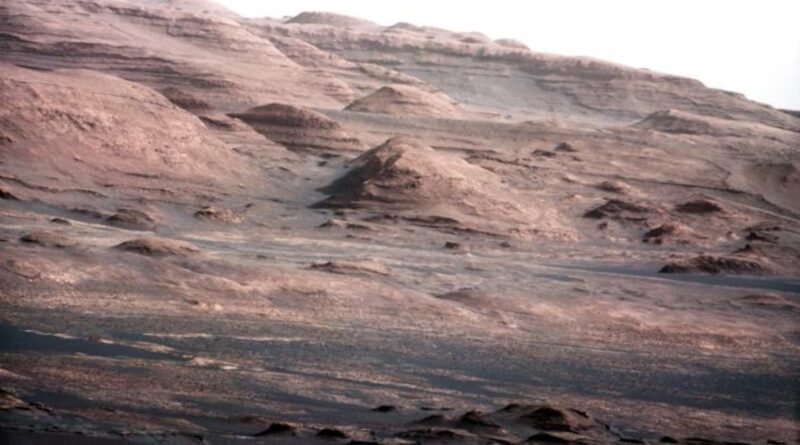Huge deposits of carbon-bearing rocks discovered on Mars

Some of the layered deposits on the slopes of Mt. Sharp on Mars have been shown by NASA’s Curiosity rover to be rich in carbonate minerals.NASA
The peak of Mount Sharpe towers 5.5 kilometers above the dusty floor of Gale Crater on Mars.
But for NASA’s Curiosity rover, which landed near the based of the mountain in 2012 and has been trundling up its rocky slopes ever since, the journey is more about the eons spanned than the metres climbed.
During its ascent, Curiosity has used an array of science instruments to examine the composition and mineralogy of layer upon layer of Martian rock that was laid down inside the crater, starting over 3.5 billion years ago, and then gradually exposed by scouring winds.
Now some of those layers examined have been found to contain a vast storehouse of carbonate rock – something that was not predicted based on earlier efforts to map the planet’s geology from space. The physical and chemical make up of the rock confirms that it dates back to a transitional period when the climate on Mars switched from warm and wet to cold and dry.
Benjamin Tutolo, a planetary geologist at the University of Calgary, is the first author on a study showing the existence of large quantities of carbonate rocks on Mars.Riley Brandt/Supplied
“We all wanted to go and see what this climate transition looked like, but none of us expected that there would be carbonate in these samples at all,” said Benjamin Tutolo, an associate professor at the University of Calgary and a participating scientist in the mission.
Dr. Tutolo is the lead author of a study that describes the finding, published Wednesday in the journal Science. The study includes the rover’s analysis of four samples extracted at various points along an 89 metre-thick section of the rock on Mt. Sharp that the rover first reached in 2022.
The samples were found to contain siderite, a mineral made of iron carbonate that accounted for up to 10 per cent of the material by weight. Dr. Tutolo and his colleagues suggest that the deposits formed as a lake environment that had previously existed in the crater began to dry out.
Significantly, this picture appears to address a key mystery about Mars’s ancient past: How and when was the planet’s atmosphere thick and stable enough to allow ample amounts of water to flow freely over its surface?
Evidence for past water can be found in many areas on Mars in the form of dried up channels and other features. However, the atmosphere on Mars now is far too thin for water to be stable in its liquid form. A bucket of water dumped on the Martian surface would immediately vaporize.
A thicker atmosphere dominated by carbon dioxide would address that riddle, but that leaves the question of where all the carbon went.
The new finding may offer an answer, as well as evidence for an ancient carbon cycle on Mars when the planet would have been more hospitable for life.
In the scenario laid out in the study, the carbon is partially returned to the atmosphere as conditions grew more acidic. Further chemical reactions occur, leading to the formation of sulphur-bearing minerals and releasing some carbon dioxide back into the atmosphere. This, in turn, may have helped to maintain and extend conditions suitable for liquid water on the surface.
“It makes sense and it fits a lot of the clues,” said Janice Bishop, a planetary scientist with the SETI Institute in Mountainview, Calif., who was not involved in the study.
Dr. Bishop, an expert in Mars mineralogy, said the new Curiosity findings square with other observations made from orbit that cover the same geological time period, including a study of clay minerals in a different location called Mawrth Vallis.
These add further evidence to the idea that conditions on Mars would have been able to support life billions of years ago. But unlike Earth, where a carbon cycle that includes minerals, volcanoes, oceans and life still persists, the carbon cycle on Mars was incomplete and shut down as the smaller planet cooled and gradually lost much of its atmosphere to space.
“Looking beyond our solar system, are we truly unique and lucky here on Earth to have maintained habitability for so long?” Dr. Tutolo said. “Our place in the universe is borne out in the study of these 3.5 billion year old rocks.”

